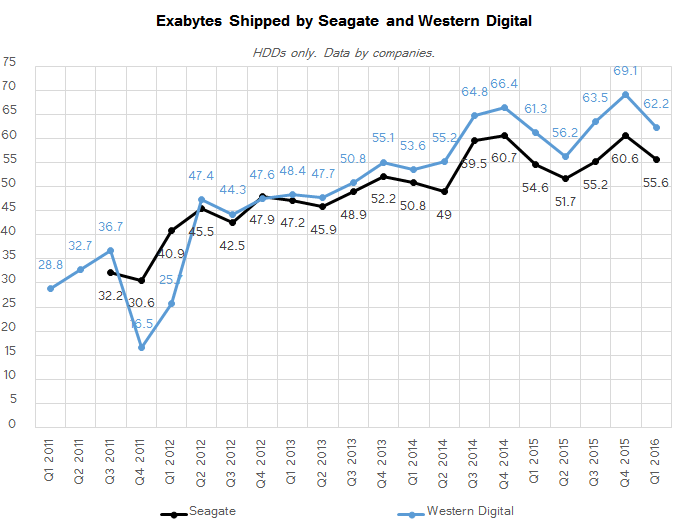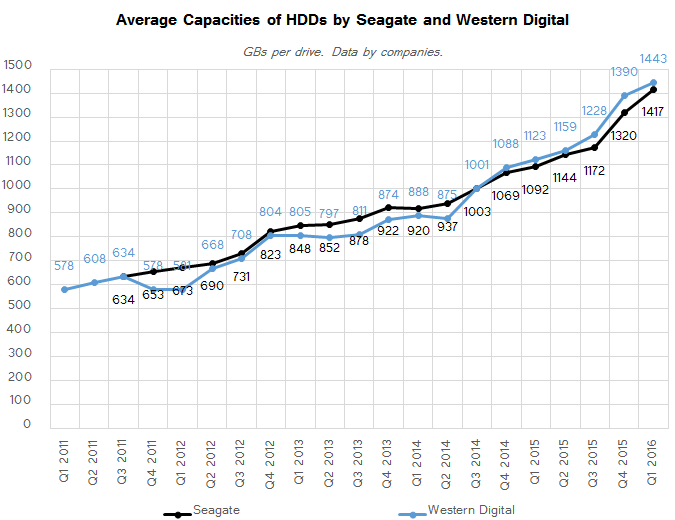Market Views: HDD Shipments Down 20% in Q1 2016, Hit Multi-Year Low
by Anton Shilov on May 12, 2016 8:00 AM ESTAverage HDD Capacities Continue to Increase
Despite the drop in HDD unit shipments, both sequentially and year-over-year, total capacities shipped by the two leading makers of hard drives increased in Q1. Seagate supplied 55.6 EB (Exabyte) of HDD storage last quarter, up from 54.6 EB in Q1 2015, but down from 60.6 EB in the previous quarter. The total capacity of Western Digital’s HDDs shipped in the first quarter of 2016 was approximately 62.2 EB, a moderate increase from 61.3 EB in Q1 2015.
When it comes to hard drives, one thing that has been growing quarter-over-quarter for a long time now is average HDD capacity, particularly in the enterprise segment, but not only there. In Q1 2016, an average drive could store around 1.4 TB of data, an increase of 28.5% (Western Digital) and 29.7% (Seagate) from the same quarter last year.
Average HDD Price Stays at $60 compared to Q1 2015
Despite the local price hikes by HDD makers, the industry can clearly produce more hard drives than it can consume, which is why prices of mass HDD models remain rather low. This will likely change in the future, when consumers shift to higher-capacity drives because of 4K UHD video or other reasons, but right now an average HDD from either Seagate of Western Digital costs approximately $60.
This will likely change after Seagate implements its plans to cut down its manufacturing capacities and supply-demand balance of the market will stabilize. However, it remains to be seen how significantly that is going to change going forward.













116 Comments
View All Comments
Gothmoth - Thursday, May 12, 2016 - link
HDD´s drop dead like flies... no wonder nobodys want´s to buy that crap.seagate is replacing my 3 month old 4TB drive with a FACTORY REPAIRED drive.
i did not pay for a second hand drive!!!
WD is not much better.
seagate cheats their customers with their crappy warranty.
jwcalla - Thursday, May 12, 2016 - link
I agree. It's one of the reasons I'm hesitant to buy any. Most of them are complete junk.SirGCal - Friday, May 13, 2016 - link
Test your drives before use. Especially Seagates. Their build practices frighten me. I have 8 4TB drives, and went through 22 drives before I got 8 that passed the tests... THAT is scary. But they've been running since release without further issues. I hear they are far better now but I still test each one before using it.jbrizz - Sunday, May 15, 2016 - link
You can probably thank weak consumer protection laws for that. In AU and NZ (and probably UK and other parts of Europe) they don't do that because it's not legal.svan1971 - Thursday, May 12, 2016 - link
The price has not gone down though...sonicmerlin - Thursday, May 12, 2016 - link
That's because the $/GB has barely budged since what it was at before the 2011 flood. I remember routinely seeing 3 TB internal HDDs going on sale for $80 before the flood.Then the HDD vendors all merged and jacked up prices while massively slowing down aerial density innovations.
SirGCal - Friday, May 13, 2016 - link
Hu? They are up to 10TB drives now in test cases and 8TB regularly purchasable... It's only 2016. Plus the cost of components has changed. I'd consider the 2011 pre-flood an all time low, rather amazing prices then a norm to aim for... Still I never saw a 3TB drive I'd buy, let alone one for that price.Burns101 - Thursday, May 12, 2016 - link
HDDs are only good for porn and movies!iwod - Thursday, May 12, 2016 - link
You can now get a very decent Plextor M7V ( TLC Based ) or SanDisk SSD Plus ( MLC Based ), both with decent Controller and Firmware support for less then $40 with 128GB.I expect the price to stay put, in 2017 once all the Fab from China and New Fab from Samsung are up, we will likely see 256GB SSD going for $40 in 2018. That should be the point where most people are fine with SSD in terms of capacity.
stevenrix - Friday, May 13, 2016 - link
The hard-drive market going down sounds like a predictive failure from their own technical jargon.It was worth mentioning that the price per gig on the hard-drives won't go down, which means that at some point in time, when the prices of the hard-drive will go up according to their bigger capacity (10 Tb, 12 Tb ...etc) and the price of the SSDs going down, then it will make it easier to switch to SSDs. In other words their strategy won't resist that much in time. Also if prices since the flood in Thailand have not much fluctuated on the hard-drives makers, the cost on the consumer went from 1 to 3 for the same hard-drive capacity. A few days before the flood I had bought around 20 Tb of drives for a few hundreds of dollars, and i have never seen those prices going back to those prices and it probably will never go back to that trend.
At a consumer level, I am willing to upgrade to 8Tb drives, but those prices are too expensive. I am pretty sure that many consumers are waiting to upgrade to bigger drives and are waiting to see the prices getting slashed. Worse case scenario I will keep buying 4 Tb drives. It is the enterprise market that help the hard-drives makers to survive, especially in the NAS enterprise market (a SAS 6 15K drive costs so much money). Maybe they should not cut production, but help to replace failed hard-drives with newer hard-drives instead of refurbished drives that will fail again in a few weeks/months to raise customer's satisfaction, because customer's satisfaction dropped to low levels a few years ago. Please make the customer happy first and they'll start buying again hard-drives. Thanks ;)